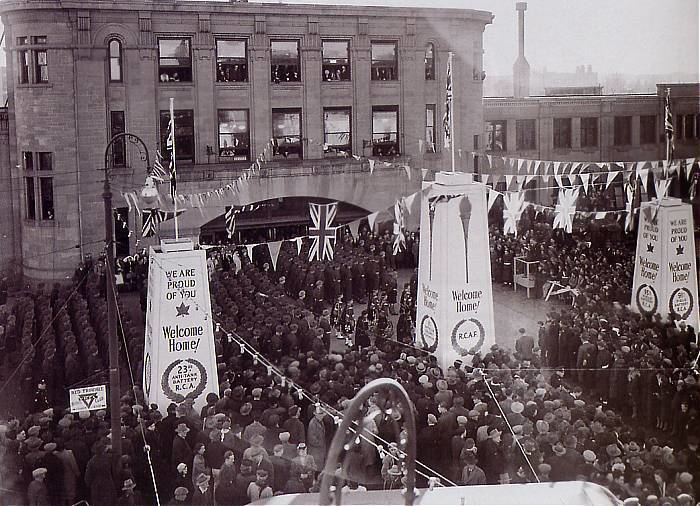 | ||
Beginning with establishment of Fort Calgary (a North-West Mounted Police fort) in 1875, the city of Calgary, Alberta, has had some degree of permanent military presence throughout its history.
Contents
Early military units
Calgary has had an active military garrison since the early years of the 20th Century. Strathcona's Horse, a Permanent Force cavalry unit, had one squadron quartered in the city for many years.
A local Non-Permanent Active Militia regiment was finally raised after several attempts by Lieutenant-Colonel William C.G. Armstrong, when the 103rd Regiment "Calgary Rifles" was authorized on 1 April 1910. Units of the artillery, engineers and supporting corps also had units in Calgary.
First World War
In 1914, several battalions of the Canadian Expeditionary Force were raised in Calgary, notably the 10th and 50th. Training took place at nearby Sarcee Camp, which grew enormously during the First World War. The camp later became known as Sarcee Training Area. Nearby Battalion Park overlooks this area.
Militia reorganization
In 1920–21, the Canadian military was reorganized, and the 103rd Regiment was split into two separate regiments, and by 1939 these were known as The Calgary Highlanders and the Calgary Regiment (Tank). Other supporting units remained in the city as well. By 1939, these included the 15th Alberta Light Horse, 19th Field Brigade, Royal Canadian Artillery, (including component subunits 23rd (Howitzer) Battery, 91st Battery, and 95th Battery), 13th Field Company, Royal Canadian Engineers, No. 13 District Signals, and No. 9 Construction Section.
Second World War
Beginning on 1 September 1939, many Calgary units mobilized for the Canadian Active Service Force. The Calgary Highlanders mobilized on 1 September 1939 and joined the 2nd Canadian Infantry Division, moving to Shilo, Manitoba in the summer of 1940 on the way to overseas employment. A 2nd Battalion was raised and served as a part-time Militia unit throughout the war. The Highlanders returned to Calgary on 24 November 1945 to a warm welcome, along with the 23rd Anti-Tank Battery (a component of the 2nd Anti-Tank Regiment) and the 91st Field Battery, Royal Canadian Artillery. The Calgary Regiment (Tank) mobilized in 1941 and eventually served in 1st Canadian Army Tank Brigade (later 1st Canadian Armoured Brigade), most famously serving at Dieppe but later being reconstituted and fighting in Sicily, Italy, and North-West Europe. A reserve unit remained in Calgary. As well, a contingent of the Alberta University Canadian Officers Training Corps was located in the city.
Post-war
By the end of the Second World War, a greatly enlarged Regular Force saw a sizable military garrison located in Calgary, and regular battalions of the PPCLI and Queen's Own Rifles, as well as Lord Strathcona's Horse (Royal Canadians) were quartered in the city. In 1995, the Regular Force garrison - including the Strathcona's, 1 PPCLI, 1 Service Battalion, 1 MP Platoon, and the headquarters of Land Force Western Area as well as 1st Canadian Brigade Group all moved to Edmonton, leaving a skeleton staff of regular personnel in Calgary to administer the local Militia units.
Permanent military facilities were completed in 1917 with the construction of Mewata Armouries, which then housed reserve units and a squadron of regular cavalry. Currie Barracks became an important training base during the Second World War, and many British Commonwealth Air Training Plan facilities were located in and around the city, including what is today the Southern Alberta Institute of Technology. Currie Barracks, and nearby Harvey Barracks, were both developed after the war to form Canadian Forces Base Calgary (CFB Calgary). A second armoury was built in a Northeast Calgary industrial park in the 1980s. Harvey Barracks (and the adjacent Sarcee Training Area) were returned to the Tsuu T'ina Nation after the lease expired, and CFB Calgary was closed. Only the headquarters for a reserve brigade and a small Area Support Unit remain.
Current units
Despite the closing of CFB Calgary (including both Currie Barracks and Harvey Barracks), the city is still home to a significant military presence of Naval and Army Reserve units including:
Army Reserve units, with their training locations in brackets include:
Additionally, there are several corps. of the Royal Canadian Sea Cadets, Navy League Cadets, Royal Canadian Army Cadets, and several squadrons of the Royal Canadian Air Cadets who train at various facilities.
